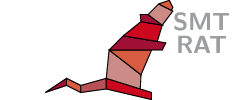 |
SMT-RAT
24.02
Toolbox for Strategic and Parallel Satisfiability-Modulo-Theories Solving
|
 |
SMT-RAT
24.02
Toolbox for Strategic and Parallel Satisfiability-Modulo-Theories Solving
|
For SMT-RAT, there are two sources of documentation: the in-source API documentation and the more manual-like documentation (you are reading right now). While the in-source API documentation is generated based on the doxygen comments from the actual source files, the manual is generated from the markdown files in doc/markdown/.
Note that some of the documentation may be incomplete or rendered incorrectly, especially if you use an old version of doxygen. Here is a list of known problems:
static_assert statements will be incomplete. A patch is pending and will hopefully make it into doxygen 1.8.9.Literature references should be provided when appropriate by citing references from the bibtex database located at doc/literature.bib using the @cite command. The labels are the last name of the first author and the four-digit year. In case of duplicates, we append lowercase letters.
These references can be used with @cite label, for example like this:
/** * @file <filename> * @ingroup <groupid1> * @ingroup <groupid2> * @author <author1> * @author <author2> * * [ Short description ] */
Descriptions may be omitted when the file contains a single class, either implementation or declaration.
Namespaces are documented in a separate file, found at '/doc/markdown/codedocs/namespaces.dox'
/** * @ingroup <groupid> * [ Description ] * @see <reference> * @see <OtherClass> */
/** * [ Usage Description ] * @param <p1> [ Short description for first parameter ] * @param <p2> [ Short description for second parameter ] * @return [ Short description of return value ] * @see <reference> * @see <otherMethod> */
These method headers are written directly above the method declaration. Comments about the implementation are written above the or inside the implementation.
The see command is used likewise as for classes.
There are some cases when documenting each method is tedious and meaningless, for example operators. In this case, we use doxygen method groups.
For member operators (for example operator+=), this works as follows:
/// @name In-place addition operators
/// @{
/**
* Add something to this polynomial and return the changed polynomial.
* @param rhs Right hand side.
* @return Changed polynomial.
*/
MultivariatePolynomial& operator+=(const MultivariatePolynomial& rhs);
MultivariatePolynomial& operator+=(const Term<Coeff>& rhs);
MultivariatePolynomial& operator+=(const Monomial& rhs);
MultivariatePolynomial& operator+=(Variable::Arg rhs);
MultivariatePolynomial& operator+=(const Coeff& rhs);
/// @}
Documentation not directly related to the source code is written in Markdown format, and is located in /doc/markdown/.